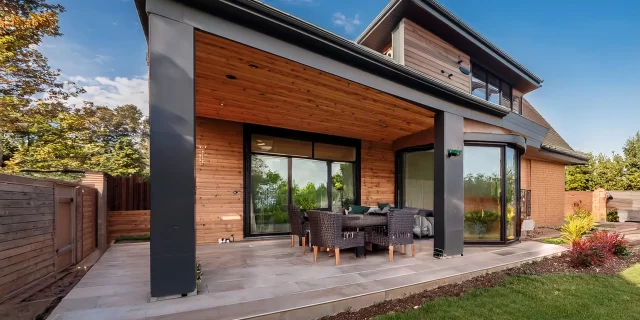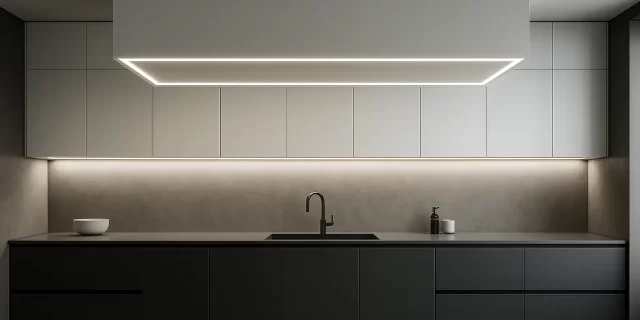Common home renovation mistakes to avoid in Toronto usually stem from a lack of planning, ditching permits, or hiring unlicensed crews.
We treat delays, cost overruns, and shoddy work as everyday nuisances.
We minimize damage by always following city codes, using skilled trades, and staying on time and on schedule. Save yourself money and headaches by being informed of these mistakes.
Our renovated guide illustrates what to avoid, who to listen to, and how to do it all the right way.
Why Many Renovations Go Sideways
Taking on a renovation project to a building in Toronto involves much more than selecting a new color of paint or new fixtures. It begins with our diligence in understanding the environment, planning for every detail, and managing expectations. When renovations skip or rush through the basics, that’s when things can really go sideways.
This blunder creates havoc, squandered cash, and work that doesn’t endure over time. We see this all the time: homeowners in the GTA jump in without a plan, hoping for quick results, only to face delays and setbacks. Here’s an overview of the most common pitfalls and how they happen.
Rushing Into Your Project Too Soon
We frequently encounter homeowners who want to begin the moment keys are received. Avoiding a careful examination can result in losing sight of how a space truly functions on an everyday basis. You demo that wall to create an open concept kitchen and can’t wait to see it come together.
Only later do you discover that you’ve lost critical storage and changed the way light moves through the room. By spending more time planning how every space will be used, we save our clients from these mistakes. Developing a wish list turned priority list of demonstrated need is key.
Put family-friendly gatherings, work-from-home needs, and storage up front, so the project is more about practicalities than aesthetics.
Setting Unrealistic Expectations Upfront
To start with, understand that many clients wish to see quick, inexpensive transformations. In Toronto, tight timelines and small budgets rarely align with reality. We never dive in without first having an honest discussion about what the available space and budget can realistically accommodate.
You will determine a line-by-line cost breakdown and review local building codes. Expect that the renovation will need to accommodate the unexpected, like finding outdated wiring or plumbing in the walls. Setting expectations during this important phase will prevent confusion and frustration down the road.
Ignoring the Planning Phase Details
A detailed plan is absolutely essential. We bring in timelines, budgets, material specifications, and design elements right from the beginning. Frequent changes during the renovation can quickly eat away at budgets and extend completion dates.
We get engineers, designers, and trusted trades involved before any demolition begins to provide insight and direction. This helps us identify problems like asbestos or out-of-date electrical before they turn into costly emergencies. Consistently monitoring the plan and making changes as required will help the project stay on course and within scope.
Underestimating Renovation Stress
Unlike new construction, renovations turn everyday life upside-down. Dust, noise, and routine disruption can test the patience of any homeowner. It’s our job to assist clients in establishing these coping strategies, whether it’s a temporary kitchen or off-site storage.
Having a contingency plan goes a long way toward preparing everyone for the unexpected. This could mean everything from a late permit to a supply chain hold up. Understanding what can go wrong and what you can do about it prevents unnecessary stress from taking over.
Smart Budgeting Avoids Money Pits
The first step to any successful home renovation in Toronto is a smart budget. Smart budgeting always saves homeowners from the anxiety of going over budget. It moves them away from purchasing money pits. Given Toronto’s current market, where material prices are going up weekly and labor is in extreme demand, this is more important than ever.
By establishing a reasonable budget from the start and having clients focus on that, we save our clients from veering off course. This practice prevents the typical money pit fate.
Why Realistic Budgets Matter Most
We insist that our clients always build a budget that brings in all real costs. This should incorporate all labor, materials, permits, and even temporary housing if needed. Electrical upgrades in older Toronto homes routinely cost more than $20,000. Ignoring this initial research can be a death knell to your budget.
We plan for the expected and the unexpected, bringing budgets in line with the project schedule and priorities. Clear, open communication regarding budget limits allows us to propose the best possible pathways and helps to prevent unpleasant surprises.
Common Budgeting Blunders Exposed
That’s not technically true, and many prospective homeowners don’t realize how fast the associated costs add up. Larger incidental costs, small purchases, such as extra tiles, hardware, or last-minute fixtures, add up fast.
We’re all for doing research on average local prices, but we’ve always suggested at least a 10-15% contingency fund. This buffer safeguards against sunk costs, for example, structural repairs found during a project. Clear, honest, open estimates are the standard, so clients never get caught off guard by hidden fees or surprises.
Building Your Contingency Fund Wisely
Smart planners never go without a cushion. We recommend that clients plan on at least 10-15% of their overall budget for those unexpected bumps in the road. This fund should be used only for true emergencies and replacements, not frivolous upgrades.
We take a look at our budgets with each milestone of the project and make adjustments while honing the details. Transparent communication eliminates any ambiguity on exactly what the contingency is there to cover – no guessing, no panic.
Tracking Expenses Like a Pro
The importance of accurate record-keeping cannot be overstated. We leverage digital tools to track every expense, categorize spending, and identify red flags in real time. This level of detail helps clients see where money goes, keeping the project focused and efficient.
Consistent evaluations provide opportunities for immediate adjustments, something that’s incredibly important in Toronto’s busy renovation environment.
Avoiding Unexpected Cost Blowouts
Surprise costs can derail a project. Solid planning prevents unexpected cost blowouts. Prior to commencing, we obtain several contractor estimates and itemize each bid thoroughly.
Our team addresses any possible overages during initial discussions, managing expectations from the start and monitoring spending very closely. We assist our clients in determining the best combination of green improvements, like energy-efficient windows and native plant landscaping.
Along with this, we temper ROI expectations so that renovations increase both comfort and value.
Finding and Vetting Reliable Contractors
Whether renovating a bathroom or building an addition, Toronto homeowners require a careful, knowledgeable approach to finding and vetting reliable contractors. We all understand that finding the right partner is the best foundation for a smooth, high-value transformation.
Our experience shows that thorough research, transparent conversations, and a focus on sustainability and quality ensure lasting results for your home and the environment. Let’s take a closer look at these best practices.
Dangers of Choosing Cheapest Quotes
Price doesn’t paint the complete picture. That’s why we emphasize the need to dig deep on what’s covered in each estimate. You might find that some contractors skip on important costs – such as permits or environmentally friendly disposal – to look less expensive.
This frequently leads to unexpected costs down the road. We strongly advise you to visit examples of their completed work and to speak with former clients. A reputable contractor with a long legacy of satisfied customers is much more likely to provide the kind of quality craftsmanship that you’re looking for.
In our demonstration projects, we’ve found that low bids, a lot below the average, indicate likely shortcuts, rushed work, or sub-standard materials. We suggest factoring in an additional 10% for unforeseen costs. We implore clients to focus on the contractor’s quality of work, rather than the overall cost.
Researching Contractor Credentials Thoroughly
In Toronto, verifying licenses isn’t a matter of choice. To determine their legal status, we advise checking a contractor’s seven-digit ESA/ECCA number. Insurance in today’s climate is not negotiable.
It’s what protects your investment and your home. We will request written estimates from no fewer than three contractors. We weigh their costs, scope of work, and sustainability of services against one another.
Reviews and portfolios can provide insight into a contractor’s reliability and your design’s compatibility with their style. In addition to providing peace of mind, background checks help protect you from expensive mistakes.
Asking Contractors the Right Questions
We come up with a specific set of questions that really get into experience, processes and how they would manage the project. Talking through payment milestones, warranties and how unforeseen complications will be addressed is typical in our contractor consultations.
Establishing communication expectations and standards upfront will go a long way in creating a positive, collaborative renovation process.
Understanding Contracts Before Signing
Each contract must clearly outline costs, timelines, and materials being used. We make sure that all terms are clearly understood, particularly those relating to amendments and conflict resolution.
We urge clients to seek clarification on any point that they do not understand – not a detail too small.
How to Manage Your Contractor
We schedule recurring points of contact and document all updates with a paper trail. Mutual professional respect and constant open communication are what make projects stay on track and moving forward.
Keeping a record of every action taken leaves no room for miscommunication, particularly when handling massive undertakings in more manageable stages to control costs effectively.
Mastering the Renovation Process
Renovating a historic home in Toronto comes with its own set of specific challenges that demand an intelligent, disciplined process. What we’ve come to understand is that mastering the renovation process takes more than just talented hands.
It takes thoughtful strategy, clear collaboration, and a profound reverence for our clients’ aspirations and the needs of the environment. We bring the same level of precision to every step, making sure each stage lays the groundwork for the project’s eventual success and sustainability.
1. Define Your Project Scope Clearly
We begin by producing an exhaustive task list and goal inventory, from floor-plan revisions to energy-neutral modernization. This is key to preventing scope creep.
Each item is prioritized both for impact and feasibility, so all time and money spent is maximized. We set everyone on the project team up with accurate expectations. If your desired project scope does shift, we make sure any new direction is in keeping with your overall vision.
2. Create a Realistic Project Timeline
We divide projects into definite phases with a hard completion date. We build in buffer time to account for Toronto’s capricious climate or supply chain disruptions.
With a shared schedule, both homeowners and contractors can remain on task. We revise the timeline as the project progresses to maintain a fluid process.
3. Expect the Unexpected Challenges
We’re all aware that there will be surprises – hidden wiring, issues with the foundation, or even delays in obtaining permits. That’s why we’re constantly coming up with Plan B.
Being willing to adapt enables us to react quickly, and we always maintain clear communication to address issues before they escalate. Over budgeting by adding a 20% contingency into the budget is a wise approach to paying for these surprises.
4. Resist Making Constant Mid-Project Changes
Frequent changes slow progress and add cost. We help clients stick to the plan, but if changes are needed, we weigh the impact first.
Every change is reviewed so the project keeps its focus and stays efficient.
5. Measure Everything Twice (Seriously!)
Precise measurements prevent expensive errors. We laser level all drawings, verify all measurements two times over, and ensure every member of our crew is doing so.
Maintaining thorough documentation protects against misunderstandings down the line during the build.
6. Document Communication and Agreements
Rather than relying on memory or ambiguous verbal conversations, we document every call, email and meeting with detailed, written records.
This establishes goodwill, prevents misinterpretation, and ensures the entire team is forever aligned with respect to approvals and revisions.
7. Know When to Consult Professionals Early
Additionally, some jobs – such as heavy electrical or plumbing work – require specialized skills. Our advice is to bring in licensed professionals early on.
We vet credentials and obtain multiple bids to ensure quality work at competitive prices.
8. Plan for Necessary Inspections
Toronto has very rigid inspection guidelines. We check for what’s needed ahead of time, plan to have areas checked at proper times, and get each area ready so checks can be done easily.
Planning for inspections in advance prevents delays and expensive rework.
Smart Design and Material Choices
Smart design and material choices are the heart of any successful home renovation in Toronto. Our smart design and material choices prioritize plans that enhance not only a place’s curb appeal, but its daily experience. We take pride in balancing aesthetics with purpose, using materials proven to last through local weather shifts and the test of time.
Each measure addresses the true issues that homeowners face, like long-term maintenance, future-proofing, and the environment. We make the process easy, and we stick to your design aesthetic.
Focusing Only on Surface Looks
We’ve watched countless projects crash and burn by pursuing only surface appearances. Bypassing those concerns is a big mistake. It’s vital to combine function with form.
Whether it’s including built-in storage or selecting a kitchen configuration that enhances workflow, these spaces are accomplishing so much more on a daily basis. We’re always thinking about how every choice will affect movement, storage, and comfort.
We make decisions accordingly, for instance selecting flooring that’s up to the task of a busy family and finishes that will handle Toronto’s humidity shifts.
Choosing Trendy Over Timeless Style
While trends can quickly go out of style, timeless design principles ensure that homes will look fresh year after year. We try to steer clients toward cabinets, tile, and fixtures that have more timeless appeal.
A calming neutral palette and clean lines provide a foundation, while unexpected pop accents give the space personality. This minimizes the chances of future buyer’s remorse or expensive renovations later on.
Our clients experience greater resale value and less anxiety over a future shift in aesthetic sensibilities.
Selecting Low-Quality Materials Falsely
When you get cheap and low-quality materials, it never fails to come back in repairs, early replacement and repair. We consult experts to find the most suitable products for Toronto’s climate, including marine-grade flooring that can withstand water damage and windows that maximize energy efficiency.
Getting it right the first time, like spending $20,000 more on natural stone countertops instead of laminate, saves a lot of hassle down the road. Those quality finishes translate into better value down the line should you choose to sell.
Ignoring Long-Term Functionality Needs
Needs change over time and can’t be overlooked. By asking the big questions early on, we help create the flexibility to adapt each space to changing needs and priorities.
Growing families frequently find themselves having to install additional outlets in their home office. They gain from establishing expansive spaces that conveniently morph from recreational sectors to festive quadrangles.
Expensive fixes in the future could be prevented with better planning now.
Forgetting Lighting’s Huge Impact
Lighting directly affects a space’s atmosphere and functionality. We augment natural light with artificial light, leveraging massive windows, intelligent light fixtures, and energy-saving bulbs.
Good lighting not only helps make kitchens safer and living rooms cozier, it raises the value of your home.
Picking the Wrong Paint Matters
Paint is about so much more than just color. It’s about protection and setting a mood. We choose tough, cleanable finishes that stand up to active households.
Seeing colors in actual light conditions will reveal any color’s true effect. Safer alternatives, such as low-VOC paints, are better for your family and the environment.
Overspending on Non-Essential Tech
We’re advocates for upgrades that make a real difference, like smart thermostats or smart security systems. That means avoiding high-tech distractions that are obsolete before the ink dries on the contract.
Each technology choice balances future value with current use, beyond the shiny new thing.
Considering Your Home’s Resale Value
Each alteration has a negative impact on market appeal. We consider neighborhood trends prior to making major investments and don’t make personalization too loud.
Upgrades like better insulation or updated wiring, though costly, sometimes $20,000 or more, make a home more attractive to future buyers and cut energy costs.
Living Comfortably During Construction Chaos
Home renovations in Toronto are usually accompanied by a flurry of dust, noise, and everyday disruption. We understand that living comfortably during this phase is no easy feat. Thoughtful planning and open communication help us keep daily life on track, even when a project runs 20-30% longer than expected – which is common.
Our approach is shaped by three pillars: environmental stewardship, high-quality craftsmanship, and a client-centric mindset. Our goal is to make living through construction as easy as possible, without compromising our sustainability commitments or family schedules.
Tips for Managing Daily Disruptions
We begin with a thoughtful proposal that limits noise, dust, and site clutter as much as possible. With the use of temporary dust barriers and quiet work schedules, we allow families to retain their sanity while construction is occurring. Being clear about your boundaries with the contractor from the beginning is important.
We collaborate with clients to determine when hours are quiet, restrict access to private spaces and maintain clear expectations. For daily disruptions, we suggest coordinating family meals and events to avoid the busiest work hours. For instance, packing lunches the night before or utilizing slow cookers can prevent an inability to use the kitchen.
Having the essentials – think toiletries, chargers, snacks – stored in convenient bins will save you stress and time when sections of your home are off-limits. By tracking progress daily, we help prevent scope creep and avoid the 5-10% cost hikes that come from change orders.
Setting Up Temporary Living Zones
We assist families in establishing safe, functional environments that are conducive to daily living. That beautiful finished basement could easily become the new family room during construction. Or, get creative and use a spare guest bedroom as both a sleeping area and a homework area.
Lightweight, portable furniture and stackable storage bins maximize space in cramped living quarters. Safety should be the first concern at all times. This is even more critical when young children or pets reside in the home.
We suggest providing well marked, wide walkways using cord covers and adding gates where possible to help keep everyone out of the construction area. By taking up residence in the home prior to construction work commencing, families will be able to identify which spaces are the most critical and prioritize work accordingly.
Keeping Communication Open with Family
Renovations are much easier when the whole family is in the loop. We recommend daily family check-ins to discuss the progress of the work, vent frustrations, and recalibrate expectations. Establishing a family meeting night or family group chat ensures everyone is up-to-date.
When problems strike, such as unexpected delays in obtaining council permits or an unforeseen rainstorm, straightforward information reduces worry. We strongly believe that if everyone’s voice is heard, everyone will feel like part of the process and not just along for the ride.







